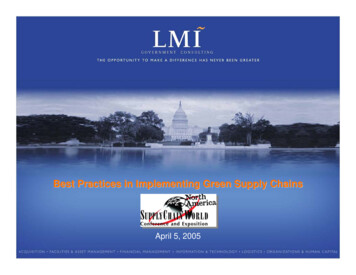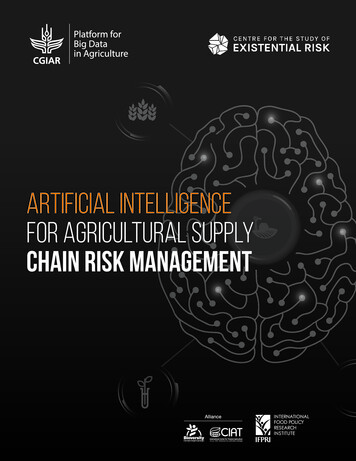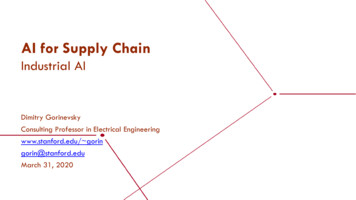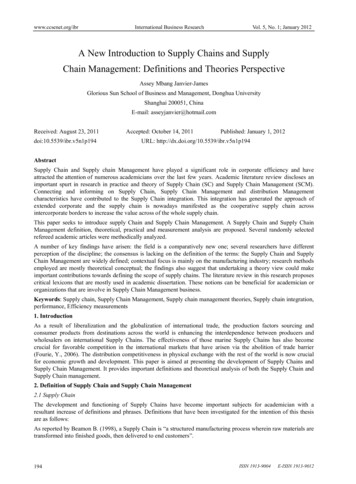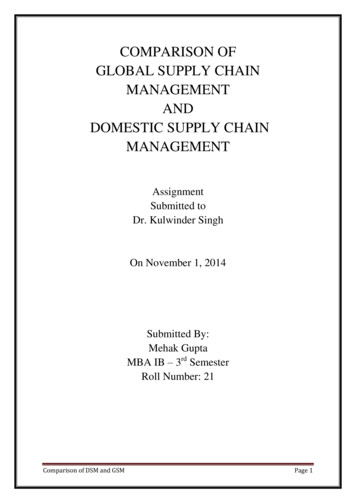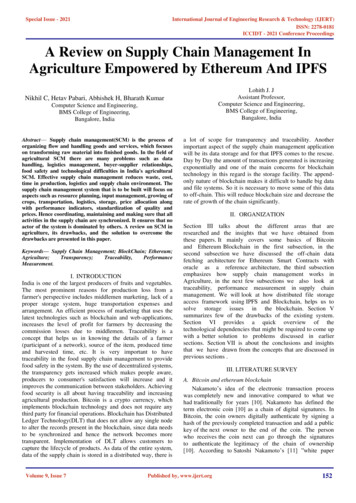
Transcription
Special Issue - 2021International Journal of Engineering Research & Technology (IJERT)ISSN: 2278-0181ICCIDT - 2021 Conference ProceedingsA Review on Supply Chain Management InAgriculture Empowered by Ethereum And IPFSLohith J. JAssistant Professor,Computer Science and Engineering,BMS College of Engineering,Bangalore, IndiaNikhil C, Hetav Pabari, Abhishek H, Bharath KumarComputer Science and Engineering,BMS College of Engineering,Bangalore, IndiaAbstract— Supply chain management(SCM) is the process oforganizing flow and handling goods and services, which focuseson transforming raw material into finished goods. In the field ofagricultural SCM there are many problems such as datahandling, logistics management, buyer-supplier relationships,food safety and technological difficulties in India's agriculturalSCM. Effective supply chain management reduces waste, cost,time in production, logistics and supply chain environment. Thesupply chain management system that is to be built will focus onaspects such as resource planning, input management, growing ofcrops, transportation, logistics, storage, price allocation alongwith performance indicators, standardization of quality andprices. Hence coordinating, maintaining and making sure that allactivities in the supply chain are synchronized. It ensures that noactor of the system is dominated by others. A review on SCM inagriculture, its drawbacks, and the solution to overcome thedrawbacks are presented in this paper.Keywords— Supply Chain Management; BlockChain; formanceMeasurement.I. INTRODUCTIONIndia is one of the largest producers of fruits and vegetables.The most prominent reasons for production loss from afarmer's perspective includes middlemen marketing, lack of aproper storage system, huge transportation expenses andarrangement. An efficient process of marketing that uses thelatest technologies such as blockchain and web-applications,increases the level of profit for farmers by decreasing thecommission losses due to middlemen. Traceability is aconcept that helps us in knowing the details of a farmer(participant of a network), source of the item, produced timeand harvested time, etc. It is very important to havetraceability in the food supply chain management to providefood safety in the system. By the use of decentralized systems,the transparency gets increased which makes people aware,producers to consumer's satisfaction will increase and itimproves the communication between stakeholders. Achievingfood security is all about having traceability and increasingagricultural production. Bitcoin is a crypto currency, whichimplements blockchain technology and does not require anythird party for financial operations. Blockchain has DistributedLedger Technology(DLT) that does not allow any single nodeto alter the records present in the blockchain, since data needsto be synchronized and hence the network becomes moretransparent. Implementation of DLT allows customers tocapture the lifecycle of products. As data of the entire system,data of the supply chain is stored in a distributed way, there isVolume 9, Issue 7a lot of scope for transparency and traceability. Anotherimportant aspect of the supply chain management applicationwill be its data storage and for that IPFS comes to the rescue.Day by Day the amount of transactions generated is increasingexponentially and one of the main concerns for blockchaintechnology in this regard is the storage facility. The appendonly nature of blockchain makes it difficult to handle big dataand file systems. So it is necessary to move some of this datato off-chain. This will reduce blockchain size and decrease therate of growth of the chain significantly.II. ORGANIZATIONSection III talks about the different areas that areresearched and the insights that we have obtained fromthese papers. It mainly covers some basics of Bitcoinand Ethereum Blockchain in the first subsection, in thesecond subsection we have discussed the off-chain datafetching architecture for Ethereum Smart Contracts withoracle as a reference architecture, the third subsectionemphasizes how supply chain management works inAgriculture, in the next few subsections we also look attraceability, performance measurement in supply chainmanagement. We will look at how distributed file storageaccess framework using IPFS and Blockchain, helps us tosolve storage issues in the blockchain. Section Vsummarizes few of the drawbacks of the existing system.Section VI provides a quick overview of thetechnological dependencies that might be required to come upwith a better solution to problems discussed in earliersections. Section VII is about the conclusions and insightsthat we have drawn from the concepts that are discussed inprevious sections .III. LITERATURE SURVEYA. Bitcoin and ethereum blockchainNakamoto’s idea of the electronic transaction processwas completely new and innovative compared to what wehad traditionally for years [10]. Nakamoto has defined theterm electronic coin [10] as a chain of digital signatures. InBitcoin, the coin owners digitally authenticate by signing ahash of the previously completed transaction and add a publickey of the next owner to the end of the coin. The personwho receives the coin next can go through the signaturesto authenticate the legitimacy of the chain of ownership[10]. According to Satoshi Nakamoto’s [11] ”white paperPublished by, www.ijert.org152
Special Issue - 2021International Journal of Engineering Research & Technology (IJERT)ISSN: 2278-0181ICCIDT - 2021 Conference Proceedingsis often credited as a catalyst to the current blockchainrevolution, the Ethereum Whitepaper was the biggestbreakthrough in unlocking the power of decentralizedtechnologies”. Ethereum was found by Vitalik Buterin and isthe second-largest blockchain next to bitcoin. The main aimof bitcoin was concentrated on the construction of a system forpeer-to-peer digital currency transfer, whereas Ethereum wasbuilt to provide a framework through which we can run all ourDApps(Decentralized Applications). In Ethereum, SmartContracts can be written in a Turing-Complete languagewhich gives developers full access, a range of options andtools to build required Smart contracts just the way they woulddo it any other programming language. When Ethereum wasreleased people saw this as an advancement in the fieldof cryptocurrency and the advantage of a high-levelprogramming language such as solidity was brought to thetable. Vitalik Buterin talks about state transition where adistributed ledger moves from one state to another by thedecision of the whole network. This injects trust, transparency,and immutability into the whole system.B. Off Chain Data Fetching ArchitectureSome components of an application may need datafetching and send to an external source, which meansOff-chain data handling in Ethereum is necessary. Thissection proposes such an architecture [7] of data carriersfor Ethereum smart contracts that would not depend onEthereum node to monitor events with little moredeploymentcosts.Thisinvolves interactionsofcomputation source, Ethereum node callback, monitor thesmart contract, contract developer register, and fetch of anexternal data source [7].The architecture contains threecomponents: Mission Man- ager, Task Publisher andWorker. Mission Manager receives missions registered byusers. It contains the event hash and contract address, wayto respond to the event, along with the queue channelresponse for the event. Missions are stored in a database.Task publisher is implemented by Node.js. It clearsirrelevant transactions, assigns generated tasks to work,captures event arguments, and new block transactions arecollected by the publisher. Worker consists of 2 modules:execution module and transaction module. It executes thereceiving command to obtain data.C. Supply Chain Management in AgricultureThe supply chain of agricultural products seems tobreak due to several factors in recent days. The surveybelow determines the different ways in which blockchaintechnology can be incorporated into the agricultural supplychain such that the entire process functions transparently. Ourtraditional agricultural supply chain consists of variousintermediate agents to realize a profit whereas producers incurheavy loss. Market trends, seasonal changes, pricing aresome of the key parameters in the agriculture supply chain.In the supply of agricultural products, processors andtraders undertake market research. Blockchain ensures thedata is immutable at any point and is time-stamped. Theentire network is very fragmented and smart contracts canVolume 9, Issue 7be utilized. Some major problems in India’s supply chainmanagement system in the field of agriculture: Usingblockchain technology to track the agricultural-food supplychain: By eliminating the need for third-party representatives[1], blockchain technology has its impact on Supply chainHACCP (Hazard Analysis and Critical Control Points).supply chain traceability which is used for food safetymainly focuses on transparency. Smart Contracts are used tosecure data origin using the OPM (Open Provenance Model).[1]. Supply demand in the agro-food supply chain: Thereare issues in the Supply Chain, such as a sudden rise indemand for a product and the product running out ofstock. Farmers (producers), dealers, and transportationcompanies are all involved in supply chain operations andmust work together to provide a product to the consumerthat meets their needs. The standard supply chain hadflaws, such as no guarantee of food safety at many stagesand a failure to provide accountability. Some of thedisadvantages are removed by using blockchain as a sharedledger over a distributed network.Supply chain managementfrom the manufacturing industry’s point of view Buyersupplier relationship is very important in the supply chainsystem. From the past few years, the Buyer-Supplierrelationship has increased its attention. “The higher level ofshared information and communications among the supplychain partners lead to improved collaboration” [2].“Integration of Supply chain is supported by many of theenablers like Information Technology(IT)” [2].Fear ofinformation system failure, disparities in trading partnercapacity, and a low level of supply chain integration aresome of the obstacles to supply chain integration. This isbecause when you are bringing the smaller things togetherand making it as one system, there will be a chance ofloopholes in the system. We need some industries to get thereview from the people like buyers, sellers, customers, etc.Selectedsectors from the Indian Manufacturing Industry are:1) Engineering sector2) Automobile sector3) Fast Moving Consumer Goods sector4) Process sector“Among these four sectors, the automobile sector is seen as aflagship bearer frequently regarded as a barometer measuringthe current wealth of a nation’s economy” [2]. We are going toinclude Automobile Manufacturers and Automobilecomponent suppliers from the Automobile sector for thesurvey. The important features of the fast moving consumergoods sector (FMCG) [2] are the need for food safetytraceability and commodity-oriented business units. Afterselecting these sectors there will be some survey questions thatare going to be asked and the rating needs to be given for eachquestion by the people based on their satisfaction with theservices.Published by, www.ijert.org153
Special Issue - 2021International Journal of Engineering Research & Technology (IJERT)ISSN: 2278-0181ICCIDT - 2021 Conference ProceedingsTable 1. Comparison of Bitcoin blockchain and ethereumblockchain:C is the programming languageused for scripting.Ethereum can be coded in TuringComplete Languages.Handling smart contracts is not easy.There is good support for workingwith smart contractsA block in Bitcoin takes 10 minutesto be added into chain.A block in ethereum takes 14 secs tobe added into the chainReward halves every 210,000 blocks.The reward do not halve, they remainconstant.As a consensus method, Bitcoin usesproof-of-work.Ethereum actually employes proofof-work, although it is in the processof moving to proof-of-stake.A maximum of 21,000,000 can becreated.There is no limit for ether creation.D. Traceability in Supply Chain ManagementFor the terms supply chain and supply chain managementdifferent propositions have been proposed by authors of [9],defines the supply chain as the “direct involvement of three ormore entities in the whole flow of products, finances, services,and information from the origin to the end, and the supplychain management as the functions required to manage theflows, aiming to improve the whole supply chain and longterm performance of individual entities”[9].The authors in [9] mentions six important elements oftraceability including:i. Product traceability: This traceability explains thetracing of the physical location of the product.ii. Genetic traceability: This traceability tells about thegenetic composition of the product .iii. Inputs traceability: This traceability will give theinformation about origin and type of products.iv. Process traceability: This traceability explainswhere ,how and when the product has been produced.Tv. Measurement traceability: Works on comparingindividual measurement results to accepted referencestandards through an unbroken chain of calibrations.vi. Disease and pest traceability: This traceability willshow how the bacteria and other microorganisms arehandled .The author[9] mentions different approaches for traceability.They are centralized, linear, and distributed. A centralizedsystem includes a shared database that will become the sourceof data and this approach has its limitations due to factors suchas storage place, security concerns, etc. A Linear system iswhere each stakeholder records his data and the part of datawill be transferred whenever asked upon. In distributedsystems, a traceability system such as blockchain’s distributedledger will take data handling and maintenance. Out of allthree Distributed approaches is the most favored one butdifficult to bring it to practice.Volume 9, Issue 7Requirement of optimized supply chains led to trials fortraceability [8]. The ultimate focus was to learn maximumabout the Blockchain technology and figure out the aspectsthat can solve the traceability problem. The most suitableapproach is to connect both the Supply Chain Actors (SCAs)and product identifications using digital certificates [8]. Thesolution can be a complete traceability system that providesboth SCAs [8] and the customers the highest level oftraceability.A conceptual framework was needed to be derived forimplementing SCM with more complete traceability. The corecomponents are provenance, chain of custody(COC) andtraceability.E. Improvement in Capability of online forensicThe digital platform of blockchain must integrate withresources in open internet legal[3], which enables to establisha digital asset dispute refining methodology. Transformingreal assets into digital assets plays a key role in enhancingtrust. The creation of the electronic warehouse receipt'straceability feature will aid in the improvement of thewarehousing process, quality inspection, inventory counting,products transfer, and delivery.Blockchain and its role in information security:The use of blockchain technology to secure food supply data:People's health and safety are at risk due to the noisy buzzingissue in food safety. Many countries have researched, built,and operated traceability systems to ensure that productquality, safety management, and control are optimised.Information security in blockchain:Building an agro-foodsupply chain traceability system can be considered an urgenttask as conventional management and traceability logic isunable to meet the demands of supervision and the fastchanging food market[4]. Governments, businesses, andconsumers all profit from blockchain technology. Thetechnological aspects of the blockchain provide thegovernment with new creative concepts while alsostrengthening the conventional government structure.F. Performance Measurement in SCMThe core dimensions of supply chain success that aremeasured in SCM are efficacy and productivity. The formerrefers to the degree of which a set target has been met,whereas the latter refers to the amount of inputs used inrelation to a given level of outputs. There are two kinds ofperformance measurement aspects as per [6]: externalperformance measurement and internal performancemeasurement.External Performance Measurement:The details for analysts and investors in the company'sreported financial statements is the parameter used for externalsuccess assessment. The emphasis has been on stockholders,analysts using financial reporting, but there is an increasingneed for businesses to evaluate their success in comparison toPublished by, www.ijert.org154
Special Issue - 2021International Journal of Engineering Research & Technology (IJERT)ISSN: 2278-0181ICCIDT - 2021 Conference Proceedingstheir rivals and the world's best corporations[6]. Types ofbenchmarking:i.Internal benchmarking: In this type of benchmarking,operations within one company are compared. E. g.,the effectiveness/efficiency of one business unitwithin an organization is compared with anotherbusiness unit.ii.Competitive benchmarking: This benchmarkinginvolves going outside the company to directcompetitors for comparison. E.g. two companiesselling similar products can implement thisbenchmarking.iii. Functional benchmarking: This is a type s of a product from onecompany are compared with functionalities ofproduct belonging to one of the contemporaries.Comparisons are made on the basis of specificationdetails and their value propositions. .seen in file sharing and storage systems. The fact that everyfile in IPFS has a unique hash ensures the originality anduniqueness of the network. Once the IPFS hash is computed,this hash will be broadcasted to the entire network, ensuresconsistency in the network and in turn among peers. The IPFScontributes a large throughput, content-addressed blockstorage model which confirms the security aspects oftransactions.Key features of IPFS as mentioned in[13]:1.Hashing: IPFS can use different kinds of hashes tolocate files with its multi-hash format. The threefields of multi-hash are as follows: The first onedenotes bytes in length and also speaks about thekind of algorithm used (SHA2, SHA3, etc.), thesecond field denotes the size of the hash which is onebyte. The size of the hash will already be in thesecond field and we can find the hash on the thirdfield.2.Garbage collection: Users can pin or unpin in theirfiles in IPFS. The block of files that is unpinned isremoved by the garbage collector. The files pinnedby the user are always retained. The files that are notremoved are pinned by IPFS. The user can pin/unpina file using an if pin. Using the ipfs-add-pincommand one can pin files in IPFS. The conceptexplained here is that code moved off-chain isidentified by its 32-byte SHA256 hash.3.Block reuse: IPFS stores data in form of 256 KBblocks, this provides a workaround to save somespace in the network. If two or more contracts havethe same bytecode, same functionality, which is morelikely in some situations, and the size required forone such contract is less than half of 256 KB thentwo or more contracts can take the same block withthe same hash. This will not create a hash collisionbut save space on the network and saves an extrahash that would have been generated otherwise.iv. Customer benchmarking: This compares performanceagainst customer expectations. It is employed by themost successful companies. This sort of comparison,under the title of market research, has been conductedby many organizations.Internal Performance Measurement:This aspect focuses on identifying a critical area of interestthat enhances entirely the supply chain objectives of customerservice and finances. An integrated performance measurementsystem needs to be designed for the provision of data insightthat will prompt people to proceed in direction ofimprovement. The following steps are included in developinga supply chain output measurement:Identifying the core elements of customer service in eachfocused market segment and establishing goals for eachaspect. These priorities can be broken down into concretetargets for each supply chain connection using the stepwisedecomposition method. These objectives are eventuallyconverted into specific primary success metrics, such asefficiency, delivery, cycle time, and waste. The ultimate goalof this strategy is to ensure the implementation of aninterconnected supply chain output measurement scheme,eliminating the situation where specific functions arecalculated and thereby handled in isolation.G. IPFS and blockchainIPFS works using the DHT(Distributed Hash Table).Compared to BitTorrent and Git file, it is not only moreproductive, but also an efficient storage system. IPFS is alsoknown as a version control system which provides featureslike scalability, security, reliability which is very rare to beVolume 9, Issue 7Reasons for using IPFS in blockchain1.To increase the integrity of Transaction: The integrityof transactions in IPFS content-addressed systemswill be increased by creating a unique hash for eachfile using algorithms such as the one mentionedabove. The Hash produced IPFS by this procedureadds durability and reliability to the transactions.2.Easy to access transaction: In the IPFS distributednetwork, once any node in the network owns a copyof the file and its hash, any peer can access the file.The important thing to notice is that if a transaction'shash gets updated then automatically the transactiongets changed or updated without changing the peersconnected to the IPFS hash.Published by, www.ijert.org155
Special Issue - 2021International Journal of Engineering Research & Technology (IJERT)ISSN: 2278-0181ICCIDT - 2021 Conference Proceedings3. Easy to distribute transaction: Peers can access thefiles to the system and broadcast the file content toother peers on the network. The PIN command willhelp to broadcast the file content to other peers.IV. ACCESS OF BANDWIDTH BY IPFSRandhir Kumar and Rakesh Tripathi[13] speaks about howdata is being stored, how it is being retrieved on a distributednetwork using IPFS that has two categories of bandwidth, ‘IN’and ‘OUT’. ‘IN’ refers to bandwidth occupied when thetransactions are uploaded or stored into the IPFS network.‘OUT’ is the bandwidth occupied when the transactions/filesare fetched from the IPFS network. The below diagram showsthe difference between the ‘IN’ and ‘OUT’ bandwidths.VI. SOLUTIONS TO OVERCOME CHALLENGESTo solve the problems listed and to integrate theactivities of the supply chain, we have designed a workflowmechanism, with help of Ethereum blockchain (along withrelated tools). Fig. 2 shows this mechanism in brief. Aswe can see, there are mainly 6 actors in the application.Farmers are producers of the chain, Suppliers are actorswho supply raw materials or agricultural equipment for afarmer. Agricultural consultants are people with scientificexpertise in the agricultural field helping farmers inoptimizing their resources for maximum usage. Transportersare people who move products between two points along withoptional storage and warehouse facilities. Distributors are theactors who buy from the farmers and this is where it reachesend-users. Funders the actor who contributes to the publicfunding aspects of a crop, and this is an optional feature in thechain for farmers. This is the basic idea which when builtupon is expected to lead to an efficient supply chain inagriculture.Fig. 1 Image showing IN and OUT bandwidthV. DRAWBACKS OF EXISTING SYSTEMFrom the study we have done on the papers listed inreferences, few prominent drawbacks in organizing a supplychain management in Indian agriculture are:1. Unplanned number of intermediaries[2]: This will lead tocost inflation even by multiple folds sometimes which canresult in infeasible cost scenarios in the market. This scenariomay also lead to tampering in market supply-demand to createvariations in cost.2. Source of traceability[2]: Although Blockchain is a greatplatform, if the source of data fed into the system is notreliable then traceability may be compromised in the system.3. Data exposure in IPFS[13][14]: The data stored on IPFS isgreat to take data off-chain when using blockchain solutions,but it's only secure until people find the hash. The contentunder the hash is not encrypted and can't be concluded ascompletely cyber secure.4. Performance measurement in the chain[6]: We have seen alot of performance measurement parameters and aspects in[6],but creating a standard and benchmark across the agricultureindustry is a challenge.Volume 9, Issue 7Fig.2 Project WorkflowA. Infura APIWhen an IPFS node is running as a daemon, Infura[15] creates an HTTP API that allows users tocontrol the node and run the commands that help inworking with IPFS. Some of the prominent IPFScommands are: add, cat, dag, get, etc.Published by, www.ijert.org156
Special Issue - 2021International Journal of Engineering Research & Technology (IJERT)ISSN: 2278-0181ICCIDT - 2021 Conference ProceedingsB. Truffle frameworkTruffle is a scriptable development environment, testingframework for blockchain using the Ethereum VirtualMachine (EVM). It helps in tasks such as compiling,migrating, testing smart contracts into the blockchain [17].[5][6]C. MetamaskMetaMask is a tool available as browser extension andmobile app, which provides the way to connect to blockchainbased applications we deployed using truffle. MetaMaskprovides users with a token wallet, secure login, keyvault, and token exchange which helps us manage our digitalassets [18].VII. CONCLUSION[7][8][9][10]In this paper, we have discussed various aspects related toIndian agriculture, Traceability, Reliability, BlockChain, andIpfs. The current Indian Agro-Food industry is not wellorganized under any hood. This is an attempt to put thingstogether in an orderly fashion. The concepts that BlockChainbrings to the table adds valuable meaning and organization tothis distorted Indian Market and agricultural sector. Using theconcepts and ideas learned from the referred papers, weconclude that creating a DApp(Decentralized Application)will solve most of the problems we discussed and create anapplication which acts as a platform for all the stakeholders inthe Agro-Food industry to come together and create a betterflow of goods and services to people.[11][12][13][14]REFERENCES[1][2][3][4]S. Madumidha, P. Siva Ranjani, U.Vandhana, B.Venmuhilan, ”Atheoretical implementation: agriculture-food supply chainmanagement using blockchain technology”, 2019.Sanjay Jharkharia and Ravi Shankar, "Supply chain management:some insights from Indian manufacturing companies", published :Asian academy of management journal, January 2004.Su Lei, Wang Haiying, Li Haiyue and Tian Weiyu, "Research ofinnovative business classification in bulk commodity digital supplychain finance", 2020 International conference on computerengineering and application (ICCEA).Daniel Tse, Bowen Zhang, Yuchen Yang, Chenli Cheng and HaoranMu, "Blockchain application in food supply information security",Volume 9, Issue 7[15][16][17][18]Department of Information Systems, City University of Hong Kong,Hong Kong, IEEE, 2017 .Bhagya Hegde, Bhagya Hegde and Mayur Appaiah, "A theoreticalimplementation: agriculture supply chain management usingblockchain technology", Proceedings of the International Conferenceon Mainstreaming BlockChain Implementation (ICOMBI), 2020IEEE.Sweeney,E.:"Supply chain benchmarking and performancemeasurement: towards the learning supply chain. logistics solutions",the Journal of the National Institute for Transport and Logistics, Vol.6, No. 1, pp. 9-13, December 2003.Xiaolong Liu, Riqing Chen, Yu-Wen Chen and Shyan-Ming Yuan,"Off-chain data fetching architecture for ethereum smart contract",Natural Science Foundation of Fujian Province, China, and MOST ofTaiwan.Pedro Ricardo Granjo de Azevedo, "Supply chain traceability usingblockchain", submitted at Lisbon school of economics andmanagement, October 2019.Parastoo Veisi, "Visualizing provenance in a supply chain usingethereum blockchain", thesis submitted to the College of Graduateand Postdoctoral Studies in September 2019.Satoshi Nakamoto, “Bitcoin: A peer-to-peer electronic cash system,”,2008. Available: https://bitcoin.org/bitcoin.pdf.Buterin, Vitalik, et al, “A next-generation smart contract anddecentralized application platform,” white paper, ki/White-Paper.DR. Gavin Wood, Ethereum: "A secure decentralised generalisedtransaction ledger", PETERSBURG VERSION 3e2c089, September2020.Randhir Kumar and Rakesh Tripathi, "Image information processing(ICIIP), Implementation of distributed file storage and accessframework using ipfs and blockchain", Department of InformationTechnology, National Institute of Technology,Raipur, 2019 FifthInternational Conference.Robert Norvill, Beltran Borja Fiz Pontiveros, Radu State from SedanGroup, SnT University of Luxembourg and Andrea Cullen fromEECS, Engineering and Informatics, University of Bradford, 2018IEEE Confs on "Internet of things, green computing andcommunications, cyber, physical and social computing, smart data,blockchain, computer and information technology, congress oncybermatics".Infura IPFS Gateway. [Online]. Available:https://infura.io/IPFS Desktop and CLI verviewMetamask. [Online]. https://metamask.io.Published by, www.ijert.org157
C. Supply Chain Management in Agriculture The supply chain of agricultural products seems to break due to several factors in recent days. The survey below determines the different ways in which blockchain technology can be incorporated into the agricultural supply chain such that the entire process functions transparently. .




